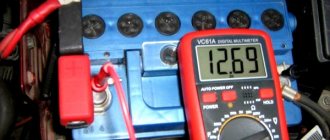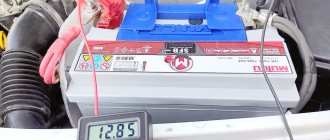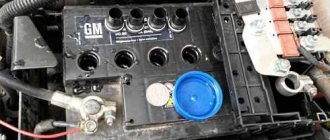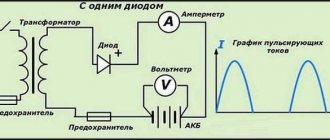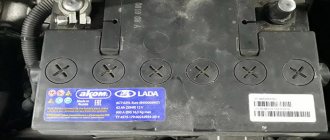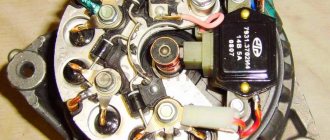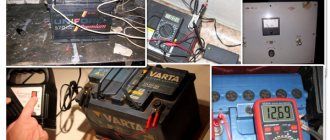Modern vehicles may have various types of lighting, music players, televisions and other elements that create a load on the power source. Insufficient car battery voltage will not allow for full functioning of all devices and accessories. In this case, it will simply not be possible to achieve comfortable operation of the machine.
Main reasons for voltage drop
A car battery works on the principle of converting chemicals directly into electrical energy. When charging, the opposite happens. During operation of the device, a current is generated due to the deposition of sulfates on the plates. The electrolyte concentration decreases, and the internal resistance simultaneously increases.
Most often, the car battery voltage is lost for the following reasons:
- The battery life has completely expired;
- the generator broke down;
- there is a current leak through the wiring;
- the chain was not designed for a certain load.
The situation can be corrected in almost all cases, if we are not talking about wear and tear of the device. Normal voltage can be restored even after using the unit for several years. Current measurement alone cannot be the basis for assessing the quality characteristics of a battery.
Normal battery voltage
The normal battery voltage is an indicator that is displayed in the documentation for the power source. If, when purchasing a new battery, it is not possible to charge it to the value specified in the instructions, then such a malfunction will be a warranty case.
If the relay-regulator and generator on the car are working properly, then the battery will be automatically charged to a normal level during operation of the car. It is advisable to strive to use the battery throughout its entire service life only when there is normal voltage at the terminals.
With significant deviations of this parameter downward in the winter, the electrolyte in a discharged battery may completely freeze, and in the summer the lead plates will deteriorate more intensively.
| Charge level of antimony and hybrid batteries at voltage in Volts | |||||
| Electrolyte temperature | 100% | 75% | 50% | 25% | 0% |
| 48,9 | 12,663 | 12,463 | 12,253 | 12,073 | 11,903 |
| 43,3 | 12,661 | 12.,461 | 12,251 | 12,071 | 11,901 |
| 37,8 | 12,658 | 12,458 | 12,248 | 12,068 | 11,898 |
| 32,2 | 12,655 | 12,455 | 12,245 | 12,065 | 11,895 |
| 26,7 | 12,650 | 12,45 | 12,240 | 12,060 | 11,890 |
| 21,1 | 12,643 | 12,443 | 12,233 | 12,053 | 11,883 |
| 15,6 | 12,634 | 12,434 | 12,224 | 12,044 | 11,874 |
| 10 | 12,622 | 12,422 | 12,212 | 12,032 | 11,862 |
| 4,4 | 12,606 | 12,406 | 12,196 | 12,016 | 11,846 |
| -1,1 | 12,588 | 12,388 | 12,178 | 11,998 | 11,828 |
| -6,7 | 12,566 | 12,366 | 12,156 | 11,976 | 11,806 |
| -12,2 | 12,542 | 12,342 | 12,132 | 11,952 | 11,782 |
| -17,8 | 12,516 | 12,316 | 12,106 | 11,926 | 11,756 |
| Charge level for Calcium, AGM and GEL batteries at voltage in Volts | |||||
| Electrolyte temperature | 100% | 75% | 50% | 25% | 0% |
| 48,9 | 12,813 | 12,613 | 12,416 | 12,013 | 11,813 |
| 43,3 | 12,811 | 12,611 | 12,411 | 12,011 | 11,811 |
| 37,8 | 12,808 | 12,608 | 12,408 | 12,008 | 11,808 |
| 32,2 | 12,805 | 12,605 | 12,405 | 12,005 | 11,805 |
| 26,7 | 12,8 | 12,6 | 12,4 | 12,0 | 11,8 |
| 21,1 | 12,793 | 12,593 | 12,393 | 11,993 | 11,793 |
| 15,6 | 12,784 | 12,584 | 12,384 | 11,984 | 11,784 |
| 10 | 12,772 | 12,572 | 12,372 | 11,972 | 11,772 |
| 4,4 | 12,756 | 12,556 | 12,356 | 11,956 | 11,756 |
| -1,1 | 12,738 | 12,538 | 12,338 | 11,937 | 11,738 |
| -6,7 | 12,716 | 12,516 | 12,316 | 11,916 | 11,716 |
| -12,2 | 12,692 | 12,492 | 12,292 | 11,892 | 11,692 |
| -17,8 | 12,666 | 12,466 | 12,266 | 11,866 | 11,666 |
Indicators in normal condition
Ideally, the normal voltage of a car battery should not be less than 12.4-12.8 volts. If the performance decreases, the power source is not able to ensure full operation of the engine, but it can be started if the generator is working. However, it is not recommended to continue using such a device, since coarse-crystalline lead sulfate may appear on the plates, which leads to a decrease in battery capacity.
A drop in readings to 11.6 volts indicates that the device is completely discharged. Its use in this condition is not possible. Here you will need a special recharge that can restore factory standards and obtain the normal voltage of the car battery at the output.
Charged battery voltage
If the battery is fully charged, the voltage will depend on the battery model. If a regular antimony battery is used, then the minimum value of this indicator should be 12.6 V.
For a calcium battery, this indicator may be slightly higher, and at the terminals of a gel battery, this parameter should not fall below 13 V. If this indicator deviates from the norm, the battery must be charged with a current equal to 10% of the battery capacity.
If the battery voltage is measured while the engine is running, the readings from the device will be significantly higher. With a working battery and relay regulator, the voltage at the terminals can reach a maximum value of 14 V.
Auxiliary table
Knowing how many volts the measuring device shows, it is impossible to know the degree of wear of the electrical power source. However, it is quite possible to determine the approximate charging percentage. To do this, use the table below.
| Readings in volts | Charge percentage |
| 12,66 | 100 |
| 12,6 | 94 |
| 12,54 | 87,5 |
| 12,48 | 81 |
| 12,42 | 75 |
| 12,36 | 69 |
| 12,30 | 62,5 |
| 12,24 | 56 |
| 12,18 | 50 |
| 12,12 | 44 |
| 12,06 | 37,5 |
| 12,00 | 31 |
| 11,94 | 25 |
| 11,88 | 19 |
| 11,82 | 12,56 |
| 11,76 | 6 |
| 11,7 | 0 |
Parameters under load
The above indicates the normal voltage of the car battery without load. However, as it turned out, it is impossible to determine the performance of the battery in this way. To do this, the device must be loaded twice as high using a special plug.
The duration of the working phase should be 4-5 seconds. The voltage should not drop below 9 volts. If there is a strong drawdown, the first thing you should do is charge the battery and recheck it. The situation will not change if the battery life is completely exhausted.
Discharged battery voltage
If the battery voltage is less than 11.6 V, then the battery is considered completely discharged. In this case, the operation of the electricity source is impossible and to restore its functionality you will need to use a charger operating from a 220 V network.
Almost all lead batteries are sensitive to full discharge. Calcium acid batteries can lose a significant part of their capacity even after a single deep discharge. The antimony device has great tolerance. Gel and AGM batteries are the most resistant to full discharge.
Normal voltage on a car battery when the engine is running
The number of volts is also measured with the engine running. Under normal conditions, the operating voltage of a car battery should range from 13.5 to 14 V. When the battery is low, the indicator exceeds the maximum value, since the generator is forced to operate in enhanced mode.
In most cases, increased voltage does not pose any danger. If everything is normal with the electrical equipment, then it returns to normal within 5-10 minutes after starting the engine. A constant increase in performance can lead to overcharging of the power source, which will cause the electrolyte to boil away.
During measurements, there is also a low voltage of the car battery. This indicates that the battery does not have time to fully charge. For testing, it is necessary to gradually turn on electrical consumers (headlights, music, air conditioning and other devices), taking measurements. If the generator is faulty, the readings will drop by more than 0.2 V.
Electrolyte density
The voltage level also indicates the density of the electrolyte. The electrolyte itself is a mixture of 35% sulfuric acid and 65% distilled water. We have already said that during discharge the concentration of sulfuric acid drops. The larger the discharge, the lower the density. These indicators are interrelated.
Hydrometer
To measure the density of electrolyte and other liquids, a special device is used - a hydrometer. In a normal state, with a full charge of 12.6V - 12.7V and an air temperature of 20-25°C, the electrolyte density should be in the range of 1.27 g/cm3 - 1.28 g/cm3.
The following table shows the dependence of density on charge level.
| Electrolyte density, g/cm3 | Charge level, % |
| 1,27 – 1,28 | 100 |
| 1,25 | 95 |
| 1,24 | 90 |
| 1,23 | 80 |
| 1,21 | 70 |
| 1,20 | 60 |
| 1,19 | 50 |
| 1,17 | 40 |
| 1,16 | 30 |
| 1,14 | 20 |
| 1,13 | 10 |
The higher the density, the more resistant the battery is to freezing. In regions with a particularly harsh climate, where temperatures drop to -30°C and below, the density of the electrolyte is raised to 1.30 g/cm3 by adding sulfuric acid. The maximum density can be increased to 1.35 g/cm3. If it is higher, the acid will begin to corrode the plates and other components.
The graph below shows the hydrometer readings at different temperatures:
Hydrometer readings at different temperatures
Taking indicators using special instruments
The above is theoretical information that allows you to familiarize yourself with the basic norms. However, you also need to know how to measure the voltage of your car battery. To take readings, special devices must be used that are connected directly to the battery terminals. It is recommended to check at an electrolyte temperature of 25 degrees.
When taking measurements without load, a tester is usually used. A specific operating mode is selected on it. The red contact is connected to the positive terminal, and the black one to the negative terminal. The display should show the current value.
Readings in a closed circuit allow you to fix the load fork. It simulates an engine starting situation by measuring the operating voltage under such conditions. The measuring device is connected to the outlets according to the same circuit. The battery is loaded for 5 seconds.
additional information
It is worth checking even the voltage of a new car battery after prolonged use. If the generator is not working well, it can gradually discharge, which means that the voltmeter readings can be much lower than normal. Recharging will be required to restore acceptable values.
It is not recommended to take measurements using an on-board PC, since the final result will have a significant error, which is explained by the specifics of connecting the device to the network. Estimates should not be used to identify problems.
A comprehensive battery check must be carried out regularly. If the vehicle has not been driven for several days and the meter shows a significant drop in voltage, the power supply has reached the end of its service life.
Features of battery operation
In order for the car battery voltage to remain normal for a long time, certain rules must be followed.
- Immediately before starting the engine, it is necessary to turn off electrical consumers. The load during one attempt should not exceed a time interval of 5-10 seconds. If the engine does not start after the fourth or fifth try, then the ignition and fuel supply systems should be diagnosed.
- Periodically it is necessary to check the integrity of the vehicle wiring. Existing current leaks in the circuits lead to rapid discharge of the battery, and hence loss of operating voltage. Electricity loss should be measured at service stations.
- When driving in the city in the winter, when the engine is running at low speeds and there are a lot of consumers turned on, it is advisable to recharge the battery using stationary chargers. In this case, the power supply device will last longer, producing the required current.
- The battery must be kept clean, especially in areas near the pole terminals. It is recommended to wipe it with a rag soaked in a solution of soda ash. You can also use an ammonia mixture.
Battery voltage in winter
In winter, constant undercharging of the battery can lead to a significant decrease in the density of the electrolyte, as a result of which the liquid inside the cans can freeze. Freezing of the electrolyte, in many cases, leads to complete inoperability of the power source. To prevent this from happening in winter, there must be at least 12.5 V at the terminals.
If a serviceable battery model is in use, the battery charge level can be monitored without using a voltmeter. It is enough to regularly measure the density of the electrolyte, which should be about 1.28 g/cm3 for a fully charged battery.
Battery charging rules
The battery must be charged in a timely manner so that the voltage during vehicle operation is optimal. When carrying out this activity, it is necessary to adhere to a number of rules.
- Charging must be done at temperatures above 0 degrees.
- Before connecting to the electrical network, the filler plugs are unscrewed and left in the mounting holes.
- You must use a device capable of providing 16 volts.
- The plugs should not be tightened for 20 minutes after charging is completed, so that accumulated gases can escape freely.
- The room must have supply and exhaust ventilation.
- The criterion for completing the charge will be the achievement of an optimal voltage or density of 1.27 g / cu. cm.
- The temperature of the electrolyte inside the device connected to the network should not exceed 45 degrees.
- It is recommended to measure current 8 hours after charging.
- If there is an indicator, then the time the device is disconnected from the network is determined by it.
